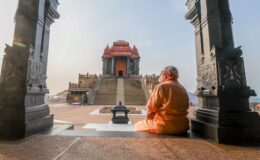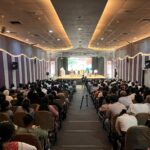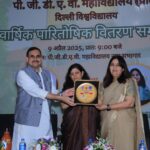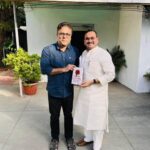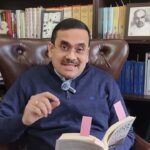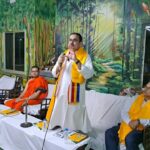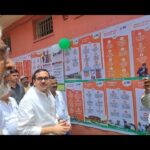STRUGGLE TO LIBERATE EDUCATION
- By : Anirban Ganguly
- Category : Articles
The goals of education as articulated by Prime Minister Modi, when he referred to Shiksha ki Sanskriti, essentially look at evolving a true and living education. The new education policy outreach is a first and fine effort at trying to assess that possibility and hope
The Ministry of Human Resources Development has completed the process of eliciting views from the grassroots on the direction and dimension that India’s education policy must take. HRD Minister Smriti Irani has termed this massive outreach as a “process of democratisation of Indian education”. Referring to the innovativeness of the effort, she observed how, “unlike the past where the consultative processes have depended on a top-down approach which involved a few experts, the current NEP consultations is undertaking an extensive, time-bound, participatory bottom-up approach”. Various Central and State educational institutions were put in charge of conducting thematic discussions, thus broadening the ambit of the effort. The response to the call for ideas and suggestions has been encouraging with the ministry asking different stakeholders to present their suggestions, recommendations, online and offline, for the NEP beyond the discussions at the village, district and State levels.
Prominent citizens, educational institutions private and public, well-known and not so-well known, participated in the exercises with great enthusiasm. At an NEP discussion organised in Hyderabad, for example, one witnessed how schools, educational administrators, educational institution heads were forthcoming and seriously participated in the deliberations appreciating the fact that they were being reached out to. Experts have also witnessed how suggestions were all well received with a commitment to take up the recommendations while drafting the final report.
It is in fact a certain section of our academia that has stayed away from the consultations, probably because it does not see a point in engaging with the ministry or perhaps because people in that section are allergic to anything that a certain Government run by a certain leader does. Not engaging, indulging in name-calling or pebble-casting hardly serves the purpose or objective of our national education.
At least, in widely reaching out to the people, in trying to gauge the aspirations of the nation in the field of education, an effort has been made — it is no one’s case that the effort has been an ideal one and leaves no room for future improvement — and the Human Resource Development Ministry under the present dispensation has actually lived up to Prime Minister Modi’s call for engaging with the people while making them feel to be an intrinsic and integral part of the process of governance. The vision of good governance in India was always based on this pillar-truth of engagement and elicitation.
The massive outreach programme across the country has indeed been staggering in its reach and response. Apart from the wide consultation of village education councils, over 29,000 citizens thought it necessary to come forward with their ideas and submitted them to that other unique platform of citizen and governance engagement, MyGov.in. Interestingly, over 15, 000 students, taking the exercise seriously, have also come forward and contributed their thoughts on how they wish India’s education system to be.
Consulting students, eliciting their views on the approaches and systems of education has always been a fundamental axiom of Indian education. Such an effort also reinforces the faith, often articulated by Ms Irani, that a policy for India’s education cannot be a one-size-fits-all; it has to recognise, appreciate, celebrate and ensure space for our uniquely diverse educational needs and expressions. For a country like India, which has civilisationally been a knowledge society, with some of the greatest, most intricate and elaborate functioning universities in human experience, such a recognition fits well into our civilisational ethos of education. The new education policy consultation, thus, may be said to be an exercise in going back to the roots and trying to explore the spirit of basic education.
It would be interesting to place this entire exercise in the backdrop of India’s educational experience. Education, in the Indian civilisational matrix, has always been a deeply participative field. The community and the common citizen played an active part in sustaining the vast and complex educational network that evolved out of the Indian civilisational experience. In fact, teachers in the Indian education framework were oftenparivrajakas who travelled around the land going from village to village ‘promotinglokasangraha’, general welfare, by disseminating values and knowledge.
The village in India, before it was deprived of its participatory and self-regenerating capacities, was an active participating unit in the promotion and sustenance of education. An inscription of the great monarch Rajendra Chola (1012-1044 CE) mentions how a village made an endowment for establishing an education centre to provide “free boarding and teaching to at least 340 students.”
Dharampal, in his The Beautiful Tree, his opus on the complex indigenous education network and tradition in India, attests to this deep community involvement in the shaping of India’s educational tradition and system. He cites British civil servant GW Leitner’s report on the History of Education in Panjab since Annexation, 1882, and argues that support for education was a widely prevalent habit among Indians. Leitner (1840-1899) undertook a detailed survey of the then existing indigenous education network in Punjab. “Respect for learning”, noted Leitner, “has always been the redeeming feature of ‘the East… The most unscrupulous chief, the avaricious money-lender, and even the freebooter, vied with the small landowner in making peace with his conscience by founding schools and rewarding the learned…”
Our education philosophers exuded a rootedness which made them futurists with an educational goal that was responsive to the essential Indian educational aim of integral development of the individual. As Sri Aurobindo eloquently put it, “That alone will be a true and living education which helps to bring to full advantage, makes ready for the full purpose and scope of human life all that is in the individual man, and which at the same time helps him to enter into his right relation with the life, mind and soul of the people to which he belongs and with that great total life, mind and soul of humanity of which he himself is a unit and his people or nation a living, a separate and yet inseparable member.”
The goals of education as articulated by Prime Minister Modi — when he referred to Shiksha ki Sanskriti — essentially looks at evolving true and living education. The new education policy outreach is a first effort at trying to assess that possibility and hope.



